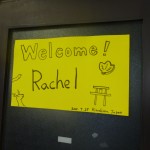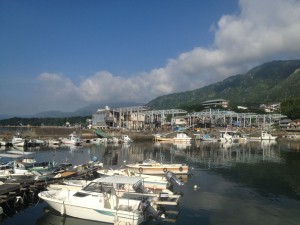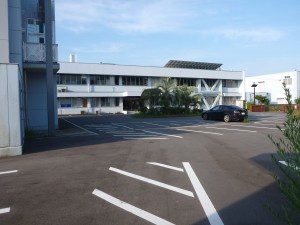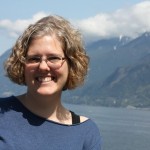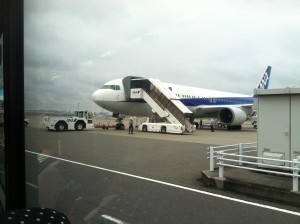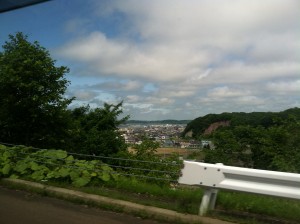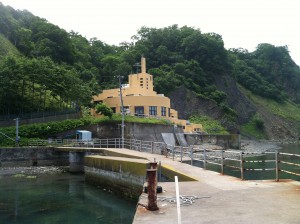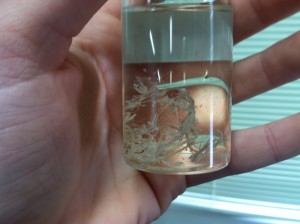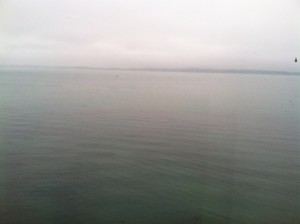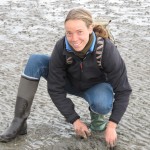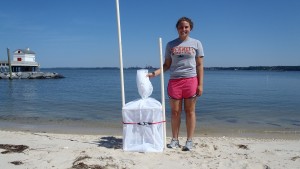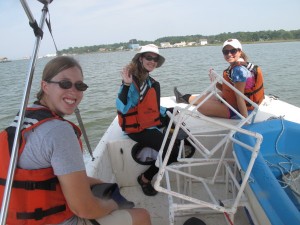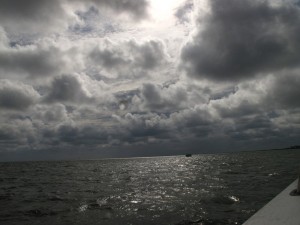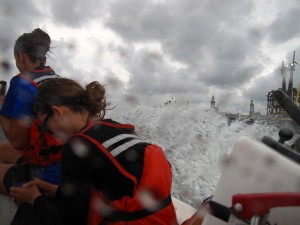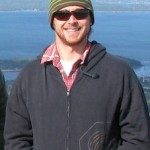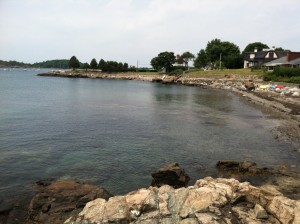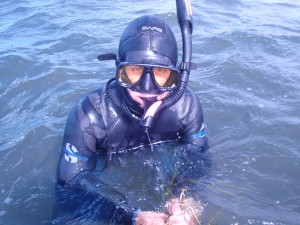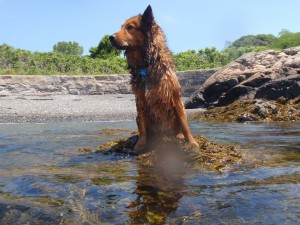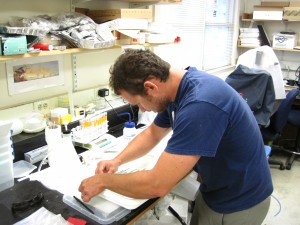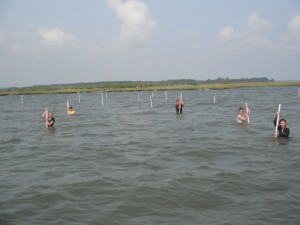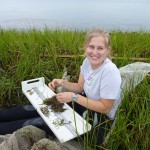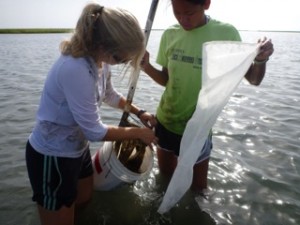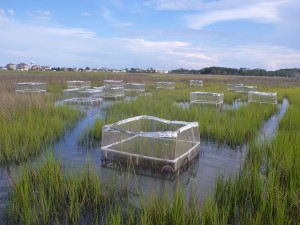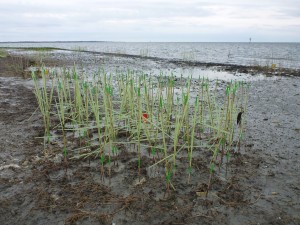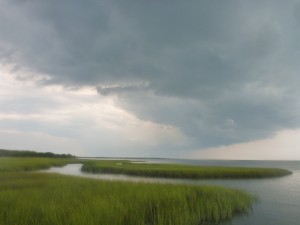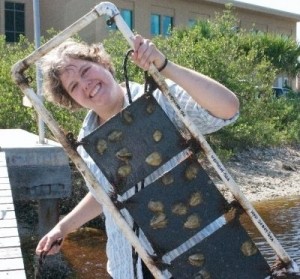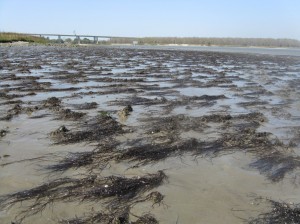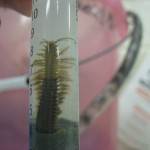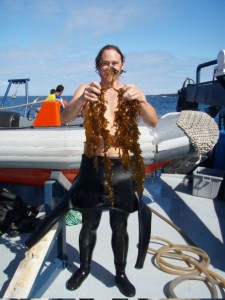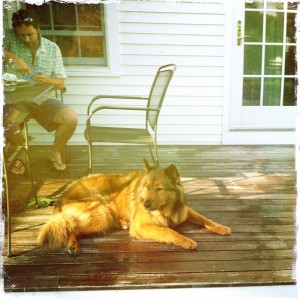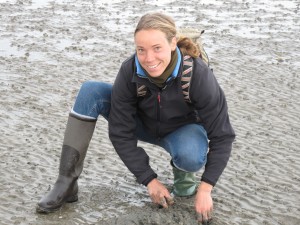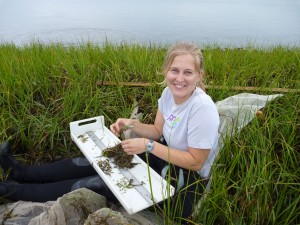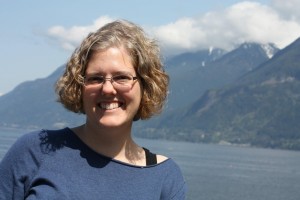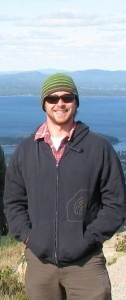First week in Hiroshima, Japan
by Rachel Gittman (ZEN graduate student fellow)
After three flights totaling approximately 17 hours, I finally arrived in Hiroshima, Japan on July 25th, 13 hours ahead and a day later than when I left Beaufort, NC.
Although I am still recovering from jet lag (5AM I am wide awake, but 3PM feels like the middle of the night), I have already begun exploring the amazing sights here in Hiroshima. I have decided to do my best to document the trip not only with blog entries, but with photos and a short documentary on the ZEN project here.
Prior to my trip to Japan, I participated in a ScienceFilm workshop led by Jeff Morales and Robert Wooten, both previous staff and current freelance documentary filmmakers for National Geographic. Graduate students at the University of North Carolina at Chapel Hill’s Institute of Marine Sciences and Duke University’s Marine Lab coordinated the workshop. Students learned how to film, edit, and produce science documentaries to help promote their research or important scientific topics. Although the course was brief (5 days), it provided an excellent crash course in filmmaking and hopefully has prepared me for making my own short film about the project here in Japan. Now if I can only remember these key tips: use a tripod, don’t zoom, and lighting matters!
Back to Hiroshima… I am working with Dr. Masakazu Hori at the National Research Institute of Fisheries and Environment of Inland Sea (FEIS), part of the Fisheries Research Agency (FRA) in Hatsukaichi, Hiroshima. Dr. Hori is the lead PI for the southern Japan site and is conducting two ZEN experiments this year: the predator assay and the predator exclusion experiment. We ran the first predation assay on Thursday and Friday of this week. The experiments are being conducted within a sheltered cove off shore of an island across from the Takehara Fisheries Research Station.
To get to the field site, we have to take a boat, which is typical for marine work, but this boat is a little different. Instead of launching the boat from a trailer or keeping it in the water, each time researchers at the station need to use the boat, it has to be lifted and lowered over the seawall into the water. It’s pretty impressive to watch and it is the perfect way to keep the boat clean!
After a 5 minute boat ride, we arrived at our site, a quiet cove filled with giant Zostera marina shoots! I was surprised at how cool the water was when I first got in since the air temperature was well into the 90s oF with high humidity. It was refreshing and although I was a bit wary of the jellyfish graduate student Matt Whalen had encountered last summer, I was soon completely engrossed in exploring the seagrass beds, or forests as I view them. The beds are extremely dense and tall, with most shoots rising more than one meter from the bottom and around 3cm wide! These beds dwarf the beds we have in North Carolina. We started an experiment measuring the effects of small crab, shrimp and fish predators, which involved some diving and snorkeling because the seagrass can grow as deep as 10m here!
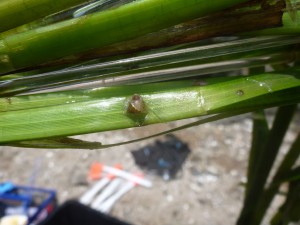 The following day we collected the experiment and found fairly high predation rates, particularly on amphipods. Although I did not spot many fish in my snorkeling adventures, clearly they were lurking in the murky depths of the beds. The visibility was poor, similar to our waters in NC, so I felt right at home.
The following day we collected the experiment and found fairly high predation rates, particularly on amphipods. Although I did not spot many fish in my snorkeling adventures, clearly they were lurking in the murky depths of the beds. The visibility was poor, similar to our waters in NC, so I felt right at home.
I am looking forward to setting up the predator exclusion experiment next week, but for now I am spending my weekend walking around and getting to know this part of Hiroshima. More to come next week…
8000 miles for science!
by Nicole Kollars (ZEN exchange fellow in Northern Japan)
Over 8000 miles is the distance I am estimating that I have travelled in the last 30+ hours from my home in Charleston, South Carolina to Akkeshi, Japan where I will be assisting Dr. Massa Nakaoka and his team with the 2012 ZEN experiment at the northern Japan site. My flight left Charleston at 1430 EST and I arrived safe and sound in Akkeshi around lunchtime… 2 days later!
With working to bring my own research in Charleston to a stopping point before heading to Japan, I did not have time to start packing until 2230 the night before my flight. Even the morning of my departure I was still making the phone calls necessary before leaving the country (banks, utility companies, Grandma) and packing right up to the last minute. Before I knew it my 40 lb backpack (which is larger than I am!) was stuffed into the backseat of my housemate’s car and we were off to the airport. On the drive there I received a call form Pamela telling me my flight to Washington DC was delayed due to weather. Upon arriving at the airport, I spent 45 minutes talking with the man at the ticket counter and learned that you should never underestimate an airline employee who knows how to work the system. First he made sure that I had a reservation on another flight in case I could not make my connecting flight to LA when I arrived in Washington D.C. Next, he had my gigantic backpack checked all the way to Kushiro (my final destination) and he had printed out my boarding passes for my ANA flights to Japan. This was amazing considering I was traveling on two different airlines.
In the end my flight to D.C. only departed 3 minutes late and actually arrived 10 minutes early. Catching my flight to LA was not going to be a problem and I even had time to find a Travelex kiosk so that I could exchange some US dollars to Japanese yen. And I must say, the Japanese banknotes are quite beautiful! With my new currency in hand, I boarded the flight to LA on time and I settled in next to a Buddhist monk heading to Burma and a young woman on her way back to Australia. We were pulling out of the gate and heading for the airstrip when the Captain announced that all flights were grounded until further notice due to severe storms over the Blue Ridge Mountains just west of D.C.. Luckily, Pamela and I anticipated potential delays when booking my flights so the nearly 2-hour standstill on the tarmac was not going to prevent me from catching the plane to Tokyo once I reached LA.
I arrived in LA a little after 2100 PST (travel time thus far: 10 hrs). The process of getting from the domestic flights terminal to the Tom Bradley International terminal (TBIT) was quite the adventure. With the chaos of LAX ground transportation (cars everywhere and incessant honking), I have to admit that when I finally walked into the arrival lobby of TBIT, I was quite overwhelmed. However, the employees at the ANA counter where I had to exchange the boarding passes I received in Charleston with the official ANA boarding passes were helpful and polite. They even gave me a head’s up about customs procedures in Tokyo which was very much appreciated.
I was half-asleep by the time I boarded the plane at 0045 PST (0345 to my US east-coast adjusted body) and I curled-up in my window seat and cannot even remember taking off. I was worried that I wouldn’t be able to sleep on the nearly 11 hr flight to Tokyo, so when I woke up 6 hrs later, I was quite relieved that I wouldn’t be arriving in Japan resembling the waking dead.
The part of the flight that I was awake for was very pleasant. The stewardesses were gracious, the seats comfortable and spacious, and the food amazing. I was anticipating the ANA provided meal ever since I read Matt Whalen’s post about his own experience travelling to Japan and I was not disappointed. There was just enough time to re-read the 2012 ZEN manual for a quick refresher of the science that awaited me in Akkeshi before the plane began its descent into the land of Nihon.
I arrived at the Tokyo Haneda airport a little after 0400 Saturday morning – Japan time (travel time thus far: 25 hrs). My first impression of the airport was that it was incredibly clean, sleek, quiet, and peaceful. I was grateful for this because I was expecting a people-filled, noisy environment of chaos, similar to what I left in Los Angeles. Customs was thankfully painless; I think the gentleman who inspected my bag was amused by the piles of neoprene that I had packed anticipating the cold water of the ZEN field site in Akkeshi. If it wasn’t already obvious that I was a foreigner, I think the slow walking pace and my wide-eyed look would have given me away in an instant as I proceeded to wonder through the airport taking it all in – the signs that I didn’t understand, the new sounds and tones, and the sleek design of practically everything.
I had one more flight from Tokyo to Kushiro before my travels were over. As the plane descended into Kushiro, I was taken back by the beautiful green forests of Hokkaido. Two members of the Nakaoka lab were waiting for me at the airport – Kyosuke-san, a 2nd year master’s student at Hokkaido University, and Kentaro-san, a research fellow with Dr. Nakaoka. It was about an hour drive from Kushiro to Akkeshi through lush wetlands scattered with small farms. We passed a couple of fields of workers stretching out long pieces of the kelp Laminaria to dry. Kentaro-san explained that the algae is harvested from the ocean, but the coast is too foggy for the seaweed to dry effectively so it is transported inland to be laid out in the sun. Seeing the fields filled with these algae reminded me of the economic importance of seaweeds and how algae are used to make so many products we use in the USA and around the world everyday, from ice cream, to toothpaste, to sushi.
We arrived in Akkeshi around lunchtime (travel time thus far: 32 hrs). To reach the marine station, you have to drive through the town of Akkeshi and travel over a long red bridge that marks the separation from Lake Akkeshi (the estuary) and Akkeshi Bay (the sea). As we drove over the bridge I saw the thick eelgrass beds that dominated these waters – I can’t wait to see these plants up close and personal when we set up the ZEN experiment here next week!
After crossing the bridge, we drove down an incredibly steep and curving hill to reach Akkeshi Marine Station. Kyosuke-san saw that I was settled into the dormitory where I will be staying for the next 6 weeks and gave me a tour of the lab. When Kyosuke-san showed me the jars of the ethanol-preserved predators and grazers commonly found in the local eelgrass beds, I was shocked by how giant the caprellid amphipods and isopods are here. They definitely are not that big back home in the Carolinas!
Over 8000 miles and 30+ hours later, I am all settled into Akkeshi on the other side of the world from home. We start the ZEN experiment this next week and I really look forward to the next 6 weeks of giant amphipods and 6 ft (over 2 m) long Zostera blades. I am grateful for the opportunity to be here, the warm welcome I have received, and the adventures that lay ahead.
When I woke up from a very long nap and looked outside my dorm window to the glassy, misty ocean view, with herons flying by and the soft sound of waves lapping the shore, my first thought was how this is all very ZEN. Literally.
Fieldwork is never boring
by Serena Donadi (ZEN exchange fellow in Virginia)
One of the most exciting days in the field was when we installed cages for an experiment examining the effects of predators (shrimp, fish, crabs) on the seagrass comminity. After spending many days cutting PVC pipes, sewing meshes and gluing parts together, our cages were finally ready! The plan was to go to the experimental site (Goodwin Islands), pound 60 poles into the sediment and attach our cages to the poles with bungees and cable ties so that the currents wouldn’t drag them away. Plus, to make the cages sink to the sea bottom, we planned to put few shovels of sand inside each mesh.
The cages are basically empty cubes (sides of about 0.5m), made by PVC poles, which are enclosed in a mesh bag. Inside the cages, seagrass communities are recreated by adding mesograzers (gastropods and crustaceans such as amphipods and isopods) and seagrass shoots attached to a plastic screen. The aim of the experiment is to keep all predators (fish and crabs) outside and see what happens… Will the populations of grazers increase? How will such an increase affect the algae and seagrass? Do we see evidence for a trophic cascade, where animals at top trophic levels promote plants at lower trophic levels by controlling species at middle levels?
The weather forecast that day was not very optimistic and there was chance of thunderstorms. We decided to give it a try and started loading everything we need on the boat. The boat was literally full! I wish I’d taken a picture. After adding 10 buckets full of sand, lots of poles, coolers with seagrass and other field. I was really afraid we would sink. But our captain for the day, Kathryn, carefully directed us as to how to load the boat to balance the weight and we were safely on our way. Once we arrived at the field site, the bad weather started rumbling and dark clouds were quickly moving in our direction. I have been in Virginia for more than one month now, but I am still surprised by how fast thunderstorms can appear here and how strong they can be. We decided to quickly head towards a sheltered dock nearby and wait for the storm to pass. After one hour we were back in the field.
It’s odd to say after so many days of terrible heat, but the water was chilly! I was glad I had my wetsuit with me. The sea was still quite rough making the fieldwork quite challenging. To be able to attach the cages to the sea bottom, I wore an incredible heavy weight belt. Despite it, the drift of the waves could still make me roll on the bottom as I snorkeled. The water was so murky that I was not able to see what my hands were doing. Sink to the bottom, stretch my legs to avoid rolling, bind the bungee around the cages and secure everything with cable ties.
After a few hours all of us were trembling because of the cold, the tide was rising, and dark clouds began to cover the sky. Finally the last cage was placed and we jumped on the boat. The sea was stormy and Captain Kathryn did an awesome job in bringing us back to the VIMS boat basin where we store the boats. On our way, heavy rain poured from the sky, hurting on our skin and blinding our eyes. I put on my diving mask and thought how ridiculous I should look wearing a mask and a wetsuit outside of the water. Eventually we arrived at the boat basin, tired, hungry and cold.
That night as I lay in my bed and thought about the day, I realized how lucky I am for having this great chance to work with wonderful people in this amazing ecosystem. It was so much fun! Really, it was one of my favorite days so far in Virginia.
An excellent day in the field
by Max Overstrom-Coleman (ZEN exchange fellow) on July 10, 2012
To be honest it is actually the 11th, but as I sit up writing this at just a shade past midnight, time seems more irrelevant than ever. I am still feeling energized from the tremendous amount of work James Douglass, my host site mentor here in Massachusetts, and I accomplished. Today we completed the sampling for the main ZEN experiment at our site. It is days like today that reinforce my love for field-work and marine science.
As I drove onto Nahant this morning the tide was halfway through its ebb and I was mentally going over the plan for what was sure to be a long day. As we envisioned it we would be in the water by about 0900 (the low was at about 1100) and our list of objectives was ambitious:
- Sample mesograzers (collect samples underwater from each experimental plot using standardized grab bags)
- Collect 10 eelgrass shoots per plot for three different analyses (1 for an analysis of epiphyte loading that would have to be done that night)
- Sample the percentage cover and canopy height of eelgrass in each plot
- Collect all of the experimental materials (bags of nutrients, plaster, and seagrass litter) to assess treatment loading and eelgrass decomposition
At this point in the season James and I are getting into a rhythm with each other. I feel like we are becoming a good team, and our ambitious plan seemed completely reasonable.
With the Northeastern Marine Lab dive truck loaded up with coolers, kayaks, dive gear and sampling equipment, we arrived at the site at a perfect tide height. The cove was empty except for a small family splashing in the shallows. It turned out that, as usual, when people show up in SCUBA gear, kids in the 8-12 age group lose their minds. I know I used to, that’s why I got certified the day I turned 13 (that was 20 years ago next week – wow I’m getting old!) and volunteered as a research diver the summer I turned 16.
It was immediately obvious that we were suddenly celebrities and it was a great opportunity to explain what we were doing and why, both to the parents and children. I think it is extremely important to communicate with the public about our research; they have to understand why it is important and see our passion. How else can we expect them to fund the science we consider so essential? In reflection, that interaction may have been one of the most important things I did today.
The sun was cooking up a hot day and it did not disappoint – I made serious strides on my raccoon tan. Before too long we were overheating and had to get in the water. I’ll spare you the nitty-gritty details, but to those of you out there who have spent that kind of time on and in the water, diving, sampling, and executing a scientific plan, I tell you honestly, it went totally smooth. By the end of it we were pretty spent and plenty hot, and it felt long but we did it without any of the usual snafus – dropped / lost / forgotten / broken gear, adverse conditions, etc… What I call an excellent day in the field.
With coolers loaded to the brim, we made it back to the lab just as we were crashing from lack of food. But after a thorough wash down to scrub off all the mud and sand that gets everywhere, and a hasty bite of food, we were back at it, preparing samples for preservation and immediately processing others. As the sunset bathed a few straggling clouds in a range of oranges and purples we were engrossed in scraping and filtering epiphytes for chlorophyll analysis, feeling pretty proud of all we accomplished. Just another day in the life of a marine ecologist.
Friendly people, stingrays and turtles: Welcome to Virginia
by Serena Donadi (ZEN exchange student fellow in Virginia)
My ZEN experience for 2012 has begun! Two weeks have already passed since my arrival at the Virginia Institute of Marine Science (VIMS) and here is my preliminary evaluation: great people, great place and great work!
First of all, I was impressed by the welcome and friendliness of the people, from my housemates to the VIMS’ stuff. The research group of Dr. Emmett Duffy is composed by graduate and undergraduate students along with apost-doc and technicians working on different projects. What’s really great is the high level of collaboration and interaction within the group. Fieldwork means hard work, limited time (the tides rule our schedule) and often adverse climate conditions (40 degrees Celsius!), and everybody knows that one person can make the difference to successfully reach the goals of the day. Helping each other is also the best way to get to know what other people are working on. Collaboration is the perfect recipe for a highly dynamic scientific environment, and the Marine Biodiversity Lab and others at VIMS are definitely a good example.
What a great place is the Chesapeake Bay! The experimental site of the ZEN experiments this summer is really beautiful. Dense beds of seagrass cover wide areas along the coast and are inhabited by an extremely rich community of organisms. The first day I saw the place I felt a bit like Alice in Wonderland. I put my hands into the dense seagrass bed and I found them covered by tens of giant (at least according to my experience) amphipods, isopods, gastropods… I jumped out of the boat and started walking. Blue crabs (even bigger than my hands!) were hiding everywhere and quickly moved away from my feet. Schools of silversides followed me, maybe attracted by the disturbance and the potential for an easy meal as my feet stirred up the sediment and associated invertebrates as I walked through the seagrass bed.
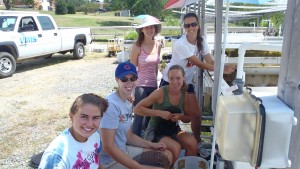
The women of the ZEN team in Virginia: undergraduates Nicole Rento, Caitlin Fikes and Katelyn Jenkins, graduate student Serena Donadi, and post doc Pamela Reynolds
After collecting myself from the marvel and the surrounding beauty, I helped my team with the tasks of the day: collecting seagrass shoots andepifaunal invertebrates, and catching and measuring mesograzer predators (small fish, crabs and shrimp). With 5 people, we managed to finish before the tide was too high and we jumped on the boat, ready to go back. As a perfect end to my first day of fieldwork, a sting ray swam elegantly in front of us and the head of a terrapin (a type of turtle) appeared at the surface . Maybe they were welcoming me to Virginia, or maybe they were just relieved that we retreating away from their home. I prefer to think it was the former.
Now that I’ve got my feet wet, I’m excited for what other adventures await me here in Virginia!
Meet ZEN student fellow, Rachel
by Rachel Gittman (ZEN exchange student fellow, Southern Japan site)
If someone told me this time last year that I would be traveling to Japan this summer to study amphipods and 3-meter tall Zostera marina, I wouldn’t have believed it. My reason for not believing such a scenario is not because I couldn’t see myself traveling to Japan, or because I didn’t think that seagrass could grow 3m tall, but because I couldn’t imagine studying amphipods. As a former lab mate of Dr. Pamela Reynolds, the post-doctoral researcher coordinating the ZEN project, I received an intense introduction to the world of mesograzers during my first year of graduate school. I swore to her that I would never study amphipods because they were just too small. Yet here I am, working with those amazing little crustaceans for the third consecutive year. I guess “never say never” is a lesson I have yet to learn.
Before I go further with my expectations for my encounters with Japanese amphipods this summer, here is some background on me. I am a third year PhD candidate in the Curriculum for the Environment and Ecology at the University of North Carolina at Chapel Hill’s Institute of Marine Sciences. My graduate advisors are Dr. John Bruno and Dr. Charles “Pete” Peterson. As a marine community ecologist, I am broadly interested in the biotic and abiotic factors that affect the structure and functioning of marine communities.
My dissertation work focuses on how two anthropogenic stressors, coastal development and sea level rise, can affect coastal habitats. More specifically, through fish community sampling and field experiments I evaluate how artificial shoreline stabilization and increased tidal inundation (a result of sea level rise) can affect the composition and persistence of coastal fish and invertebrate communities that utilize salt marsh, oyster reef, and seagrass habitats. My research often requires me to sample fish at night, trudge through dense, mosquito-infested marsh to survey the plant communities, and count and often tag many a periwinkle, fiddler crab, and other interesting marine invertebrate.
Life outside of graduate school
When I am not knee-deep in a muddy salt marsh collecting fish, I somehow manage to still enjoy being outside by running, swimming, kayaking, and walking my dogs. I also enjoy yoga, cooking, gardening, and just in case I don’t already sound a bit older than I actually am, even knitting. When I find the time to get away, I like to check out local music and restaurants, as well as escape a few times a year to the Appalachian Mountains to camp and hike.
Concern for habitat forming species unites us all
Although my dissertation work has a very different focus than the ZEN objectives, ultimately they both revolve around understanding the factors that affect the health and persistence of foundation species (e.g., the eelgrass Z. marina, marsh cordgrass Spartina alterniflora, and the eastern oyster Crassostrea virginica) that provide critical habitat for marine organisms. It is this parallel that first interested me in the ZEN project and continues to drive my participation in the network. I have been working with the ZEN partners as the North Carolina site coordinator since 2011. I am very excited to expand my participation in the ZEN project by traveling to both Hiroshima and Akkeshi, Japan, this summer to assist fellow researchers with this amazing project.
My primary expectation for this project is that I cannot know what to expect, which is very exciting. I imagine that the seagrass beds in Japan will be very different from those in North Carolina, which I am sure will pose unanticipated challenges, but also unexpected insights into the dynamic relationships between mesograzers, their predators, and the in-common foundation species Zostera. I am looking forward to working with the Japanese researchers and learning more about Japan’s ecosystems.
Meet ZEN student fellow, Nicole
by Nicole Kollars (ZEN exchange student fellow, Northern Japan site)
My name is Nicole and I am a Master’s student working with Dr. Erik Sotka at the College of Charleston in Charleston, South Carolina (USA). Erik first introduced me to the ZEN project at the North Carolina site earlier this summer and I am looking forward to continuing my experience with ZEN as a student fellow in Japan! I heard that the eelgrass there is up to a meter long (that’s over three feet!) and I can’t wait to see what else may be different (or the same) compared to the other ZEN site I’ve worked at, Middle Marsh, in North Carolina.
Growing up on both coasts
My family is from Minnesota and my parents moved back there a few years ago. I learned how to talk while in California, grew up in Washington State, and went to high school in Oklahoma. After graduating with my Bachelor’s in 2007 from Western Washington University, I lived in Florida, New York, and Oregon before landing in South Carolina for graduate school.
More about me...My favorite color is purple. When working at the fast food restaurant chain Wendy’s, I could make a junior bacon cheeseburger in 3.9 seconds. I swam varsity in high school. I took 9 years of piano lessons. I go a little crazy when given a blank canvas and oil pastels. I really don’t like scary movies or raw onions. Give me a head lamp and a midnight-low tide and I won’t stop smiling for a month!
The science of species invasions
I absolutely love science, especially marine critters. As a Master’s student, I am working with Erik and our collaborator, Dr. Jeb Byers at the University of Georgia, studying the ecological roles of the invasive red seaweed Gracilaria vermiculophylla in the mudflats of the southeastern US. My thesis research focuses on two aspects of this invasion: 1) tracking the invasion history of Gracilaria using a global population genetics approach (if anyone sees Gracilaria and is willing to send us samples please let me know!) and 2) investigating the nature of the relationship Gracilaria forms with a decorating tube worm (the polychaete, Diopatra cuprea).
Going to the ‘birthplace’ of an invasive marine algae
I have spent many a days covered head-to-toe in mud getting to know how Gracilaria looks, feels, and “behaves” in South Carolina, but I have no idea about the ins-and-outs of Gracilaria in its native habitat. How is it different, how is it the same? Well, it just so happens that the type locality for Gracilaria is in Akesshi Bay, Hokkaido, Japan! So I not only have the privilege of helping the ZEN partners in Japan but I also have this amazing opportunity to see Gracilaria in its home waters. It is most definitely a young marine ecologist’s dream come true.
It goes without saying that I am really stoked to go to Japan. I am excited not only to take advantage of the opportunity to learn all I can about native Gracilaria, but also to experience a new culture and a new eelgrass bed. I think the most challenging aspect of working in Japan will be the language barrier, but hopefully I will be able to pick up the basics quickly. I have a Japanese friend here in Charleston who is doing what she can to teach me the essentials. I’ll be boarding the plane to Japan with open expectations but I do hope to come back to Charleston with a new perspective on science and life. I’m looking forward to keeping everyone updated with what I learn, see, and experience as I explore the seagrasses and seaweeds of Japan.
Next time you hear from me, I’ll be in the land of Nihon!
Meet ZEN student fellow, Max
by Max Overstrom-Coleman (ZEN student exchange fellow in Massachusetts)
My name is Max. I’m a PhD student at Dartmouth College in Hanover, New Hampshire USA studying seagrass ecology. I’ve always been interested in marine biology. When I saw my first Jacques Cousteau film I knew I wanted to dedicate myself to exploring life underwater. Certified to dive when I turned 13, I took my first job as a research diver when I was 16 and never looked back. After studying coral reef cleaning symbioses in the Yucatan Peninsula for my undergraduate thesis at the College of the Atlantic, I struck out for California and the great Pacific Ocean. There, I learned of the concept of a foundation species while researching the effect that kelp, algae from the order Laminariales that can form dense forests underwater, has on both the physical and biological structure of an ecosystem. Foundation species are “a single species that defines much of the structure of a community by creating locally stable conditions for other species, and by modulating and stabilizing fundamental ecosystem processes” (Paul Dayton 1972).
Habitat forming species give life to underwater landscapes
I quickly developed a love for these habitat-forming species and I was intrigued by their influence on animal communities. That interest drove my research at Moss Landing Marine Laboratories, where I earned a master’s degree in marine science under Dr. Michael Graham. Having returned to the East Coast and the ocean I was first introduced to, the intrigue of foundational species continues to motivate my PhD research at Dartmouth College. I currently study how foundation species affect their associated communities, particularly the mechanisms influencing the role of Zostera marina (eelgrass). As with kelps, the presence of eelgrass drastically alters the physical environment and provides essential habitat for a diverse community of plants and animals. Eelgrasses influence these communities via their leaves, which provide substrate for epiphytic algae as well as offering small crustaceans, gastropods and fishes refuge from predation. These interactions are important because epiphytes are known to fuel these coastal food-webs and the refuge offered to small animals that eat epiphytes is thought to positively influence the growth of the seagrass itself.
Unfortunately, a pattern has recently emerged: seagrasses are in decline in New England and globally. The loss of seagrass populations and reductions in their density can have community-wide consequences including loss of commercially important species. My research is aimed at understanding how reduced eelgrass density affects epiphytes and the animals that depend on them. This summer I am excited to learn more about eelgrass and the role they play in structuring the communities that exist in the habitat they provide. My participation in the ZEN project will allow me to work in an eelgrass bed in Nahant, Massachusetts, help me to understand what is important for eelgrass growth and persistence and investigate what happens when it declines or is lost from a system.
Outside my life as a marine scientist
I currently live in Thetford, VT with my fantastic wife Amanda and our wonder-dog Jackson. We live on about 4 acres of land. When I am not working on the coast or studying at Dartmouth you will find me rock climbing, hiking with Jackson or working on our house/land. My recent projects include reclaiming an old apple orchard and re-siding our barn. I am especially excited about the orchard because it looks like we can expect moderate production this year (200-300 gallons) and it to increase thereafter (over 1,000 gallons next year)! Our other project for the summer are to replace our decrepit porch with a structurally sound deck on which we can enjoy BBQs and the cool night air.
Meet the ZEN exchange student fellows!
This summer we have four outstanding graduate students traveling to different ZEN partner sites. These ZEN “exchange student fellows” will be assisting with all aspects of the research at their host sites, from fieldwork to labwork, and in the process learning new research skills and about the local culture. See below for a quick synopsis about each of our four student fellows and stay tuned as they will be writing periodic posts about their experiences throughout the summer.
Serena Donadi is a PhD student at the University of Groningen in the Netherlands advised by Drs. Klemens Eriksson and Jeanine Olsen. Serena assisted with the ZEN experiment at the Northern Norway (NN) site last summer. She is working at the ZEN site in Virginia this summer. Her dissertation research examines the role of mudflat ecosystem engineers (cockels, lugworms, mussels) on sediment stability and the structure of the benthic community in the Wadden Sea.
Rachel Gittman is a PhD student at UNC-Chapel Hill working at the Institute of Marine Sciences in Morehead City, North Carolina, USA, advised by Drs. John Bruno and Pete Peterson. She was the local contact and helped with the ZEN experiments in North Carolina both last and this year. She will be working with Dr. Masakazu Hori at the southern Japan site (JS) and assisting with projects at the northern Japan site (JN) starting at the end of July. For her dissertation, Rachel is studying the effects of shoreline development on functioning in salt marsh and seagrass habitats in coastal North Carolina in addition to exploring food web interactions in these systems.
Nicole Kollars is a master’s student at the College of Charleston in Charleston, South Carolina, USA, advised by Dr. Erik Sotka. She assisted with the ZEN experiment in North Carolina (NC) this summer and will be working with Dr. Massa Nakaoka at the northern Japan (JN) site starting at the end of July. Nicole’s master’s research focuses on the ecological roles of the invasive red seaweed Gracilaria vermiculophylla in the mudflats of the southeastern USA.
Maxwell Overstrom-Coleman is a PhD student at Dartmouth University in Hanover, New Hampshire, USA, advised by Dr. Brad Taylor. He recently started working at the ZEN site in Massachusetts with Dr. James Douglass. Max’s dissertation work focuses on the role of eelgrass as foundation species and their effects on abiotic habitat parameters in estuaries in the northeastern USA.

